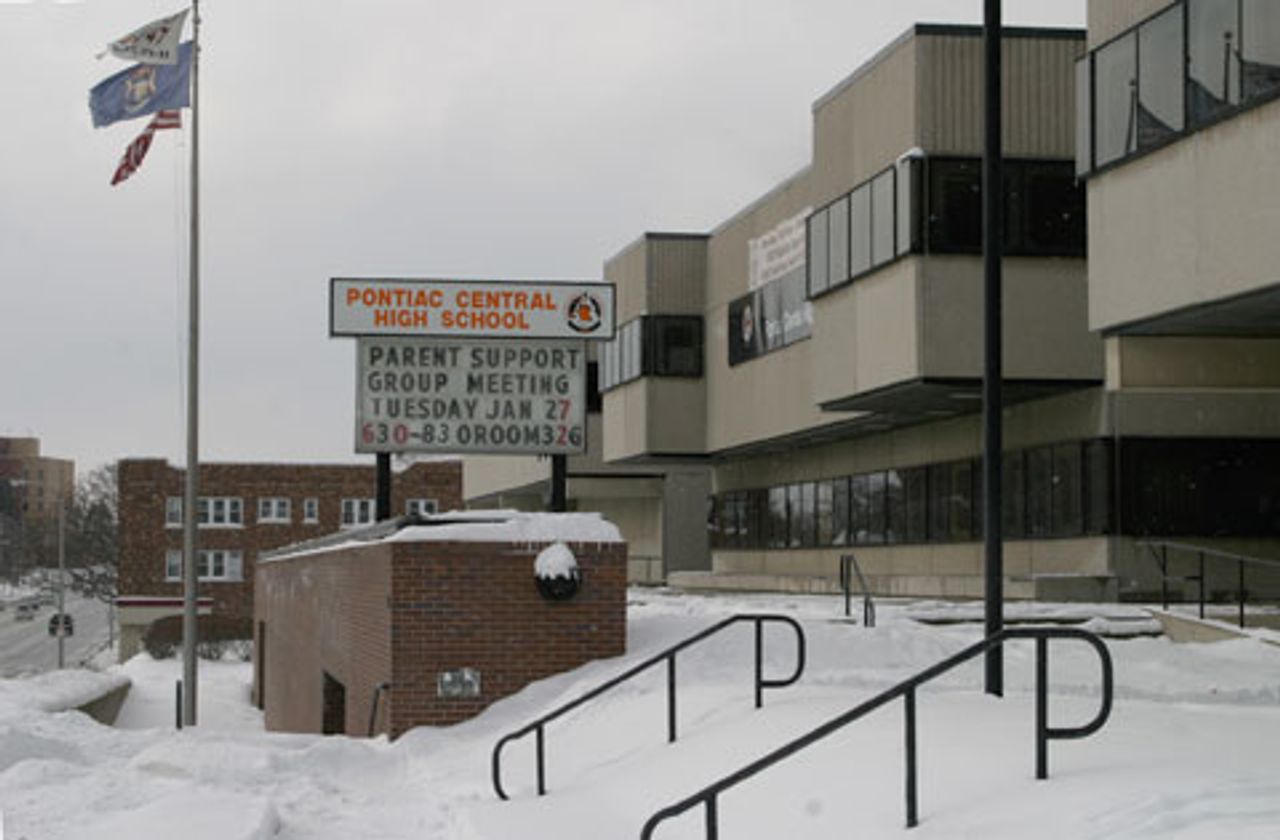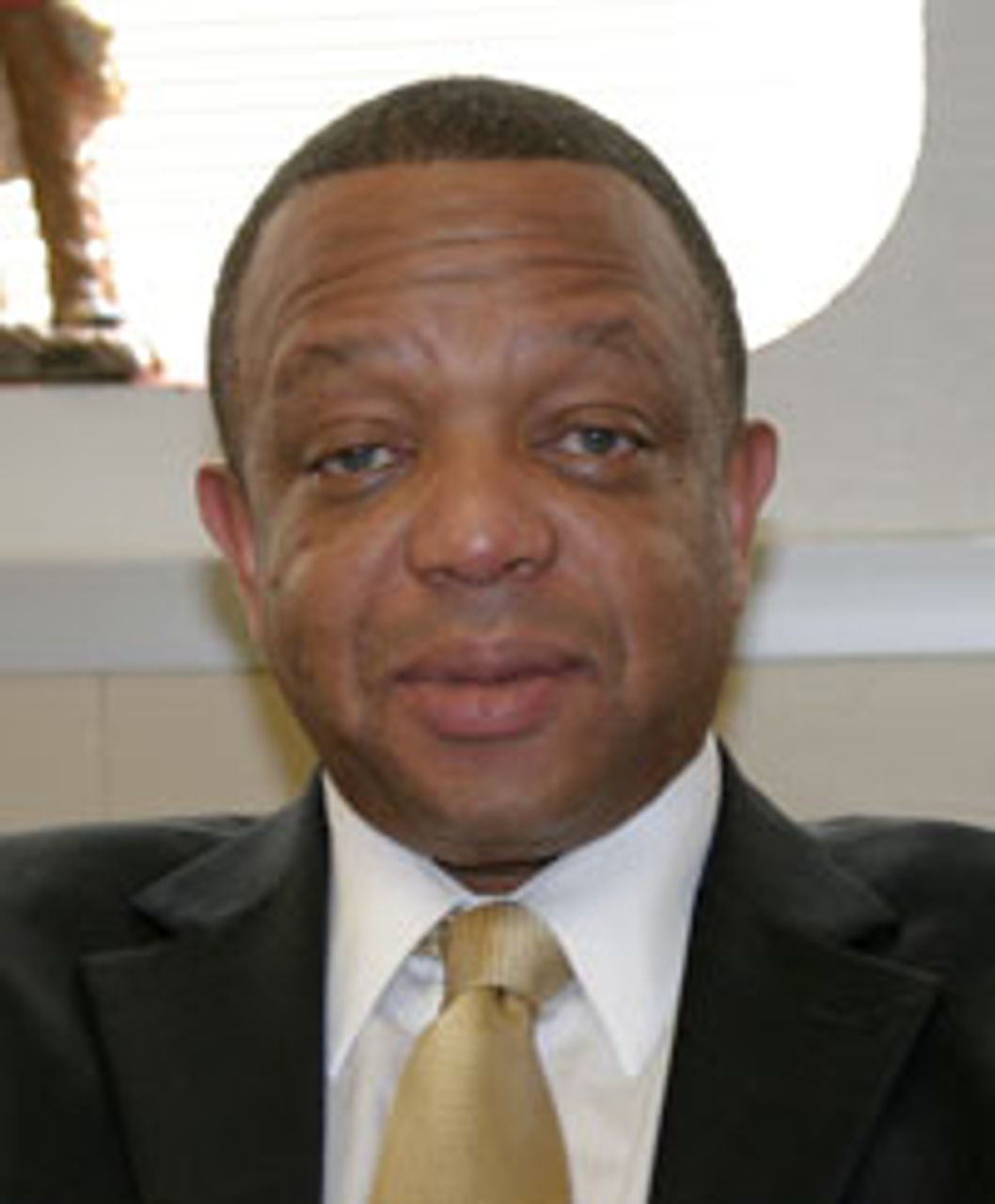 Pontiac Central High School--slated to close
Pontiac Central High School--slated to closeThe Pontiac School Board announced in late January that it would close nine of the twenty schools in the district, including half of the elementary schools, in the face of a projected $10 million deficit for the 2009-2010 school year.
The proposed draconian cuts graphically illustrate the demise of Pontiac, a city made famous by the popular General Motors cars built there. This once teeming auto town has a long and proud history. Pontiac became a GM town exactly 100 years ago, when the company purchased Oakland Motor Car Company in 1909.
GM pioneered the Pontiac brand, borrowing the name of the town that honored the courageous Native American chieftain who united tribes between the Mississippi, Florida and Canada to fight the British in 1763. The city’s name was adopted for the “athletic, performance” division, Pontiac Motors, in 1946 and would also become the birthplace of GM’s sprawling Truck and Bus Division.
Alongside the demise of the car that bears its name—the Pontiac has been relegated to a “niche” brand as of December 2008—the city has been devastated by the overall collapse of the auto industry. The GM Truck and Bus plant was a three-plant facility that once employed tens of thousands of autoworkers producing trucks, motor homes and buses. It closed in 2005. Pontiac Assembly has a vastly reduced workforce of about 1,000 workers.
Even before auto manufacturing came to the city, Pontiac had a proud tradition of cultural development. Its central location and well-kept homes and neighborhoods attracted working people and professionals. Woolen and gristmills made use of the Clinton River as a power source in the 19th century, and a railroad was built through the downtown area in 1844.
In 1849, Central High School became one of the first accredited high schools in the state. It is now one of the schools slated to shut down. These latest cuts are in addition to the six schools that have been closed in the last five years.
In addition to Pontiac Central, the district plans to close Lincoln Middle School and Bethune School, an alternative high school for grades 10-12. Crofoot, Emerson, Franklin, LeBaron and Longfellow elementary schools will be shuttered along with the Dana P. Whitmer Human Resources Center.
School enrollment in Pontiac has dropped from 8,000 at the end of the 2007-2008 school years, to about 7,200 today. The school board voted to merge the two high schools into one, with the same process applied to the middle and elementary schools. The district is proposing to change from a neighborhood school system to an attendance center school system.
For elementary students, this would mean one of the three schools would have Pre-K through 1st graders, another, second and third graders, and the other fourth and fifth graders. This would create conditions where elementary-aged children from one family could be attending three different schools, traveling longer distances to get there.
School officials made the cuts on the recommendation of an advisory panel consisting of teachers union members, parents and community leaders. No one in an official capacity has acknowledged intended layoffs in the coming year, although job cuts appear highly likely. One news report said the district would try to sell or repurpose the closed facilities.
Pontiac Education Association President Irma Collins, head of the teachers union, supports the closures, telling the Detroit News, “The board should have voted to close one of the high schools at least three years ago.”
However, Collins acknowledged the danger of overcrowding in the elementary schools. “They’re closing too many elementary schools,” she said. “Students are not going to be leaving the district in large numbers and the classrooms are going to be overcrowded, even though the union contracts say we have a limit. We’re not going to be having the teachers taking on 40 students in a classroom.”
A review of the city’s economic indices explains why the school system is declining. Michigan’s unemployment rate is 10.6 percent, the highest in the country. Pontiac is a ghost of its past with an official unemployment rate of 15.1 percent, one of the highest in the state.
According to the US Census, nearly a third of Pontiac’s residents—31.3 percent—live below the poverty line, one of the highest levels in the state. The poverty rate for children under 18 is a staggering 43 percent, the highest in Oakland County. Pontiac’s children are 10 times more likely to be impoverished than children south of the city’s border in neighboring Bloomfield Hills.
Pontiac’s mayor, Clarence Phillips, told the media that of the 12,786 owner-occupied housing units in the city last year, over 1,000 foreclosures took place, with as many or more expected in 2009.
The state of Michigan lost 200,000 manufacturing jobs between 2000 and 2007, the overwhelming majority in auto and related industries. The combined losses of jobs and tax revenues have devastated Pontiac, where median household income has now fallen to $31,000 per year, far below the national median of $44,334.
This figure is particularly stark when considering that autoworkers—with their families in the past forming the core of the Pontiac community—were previously the highest paid non-skilled workers in the US. All this has changed—beginning with the concessions granted by the United Auto Workers union in the 1980s, followed by a steady erosion of auto jobs and plant shutdowns.
The population of Pontiac is presently 66,337. Unlike Detroit, it is a racially diverse city, with a population comprised of 39.09 percent white, 47.92 percent black, and 12.7 percent Hispanic. This diversity was clearly reflected at Pontiac’s Central High School when the WSWS visited recently.
 Dr. Brian Yancy
Dr. Brian YancyDr. Brian Yancy, head principal at Pontiac Central, spoke about the impact of the cuts on the school and its history. Yancy, a former Central student, has only been on the job for one-and-a-half years. “I’m one of those who will possibly face the loss of their jobs,” stated Yancy.
When asked why the cuts were taking place, Yancy said the cuts were the result of the combined effect of diminished state funding due to declining enrollment and a decline in local property taxes because people have moved out of the area. “As we don’t sell cars, that funding begins to be depleted,” he said.
Yancy said the greatest amount of money comes from the state, based on head count. “So, as the economy declines and people move out of the area, by necessity they take their children with them. And so you get a collateral drop in enrollment because of that.”
Yancy said the poverty level is very high in the school. “Our poverty levels are so high that we have a ‘school-wide’ lunch program. It is more efficient to say that everybody in the building is in poverty than to try to tease out the small percentages that are left.”
Despite the poverty, Yancy said he was proud of the school and felt the students had a positive attitude about their capabilities. “The sports program has a history that is unrivaled in the state,” stated Yancy, adding that no other school can claim to have had two Olympic gold medalists, one in track and field and the other in swimming.
Yancy said the school has one of the finest marching and concert bands in the country and participated in the statewide contest in robotics.
“Central is the oldest accredited school in the state,” he added. “It was established in 1849 and has the largest alumni association in the state. It is coming up to its 150th anniversary. This is what disheartens people in the community and the surrounding area about Pontiac Central.”
Despite his fondness for the school, Yancy said he agreed with the decision of the board to close the schools, believing the board had to respond responsibly to the loss in student enrollment.
Many students and parents in the region, however, were opposed to the cuts and were concerned that more wasn’t being done to put more money into the school system.
Like many distressed inner-city areas, Pontiac is plagued by gang activity. Devin Fears, a student at Central, told the WSWS that he was concerned that the school mergers would intensify this problem.
 Jason Burcham
Jason Burcham“People are worried,” Devin said. “If there were no gangs, it would be good. The sports teams in both schools are good. It’s just that there are too many gangs in both schools. People are starting to get hurt.”
The WSWS spoke to a number of Pontiac residents, who expressed their concern and anger over the proposed school closings. “The schools are supported by the public,” commented Jason Burcham, who said he was concerned about the impact it will have on the entire city. He said a good school system is “one of the ways to bring quality to the district.”
“It’s like the chicken or the egg,” Jason added. “We need the investment in schools; otherwise we will have more abandoned houses. It’s a vicious cycle.”
 Gwen Reed
Gwen Reed
Gwen Reed did not agree with the cuts. “I don’t think it is a good idea. They have already closed a lot of schools. It’s hard on everyone to get kids to school as it is. It will be even harder with the cuts.”
Nitzia Rodriquez also opposed the school closings. “It’s a shame, really,” said Nitzia. “It’s going to be chaotic. The government needs to step forward and help the districts. They should stop wasting it on other things like wars.”
